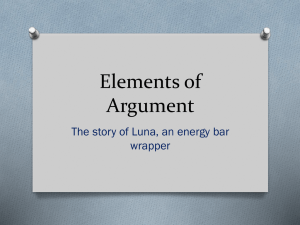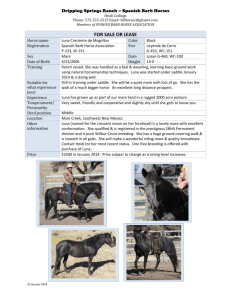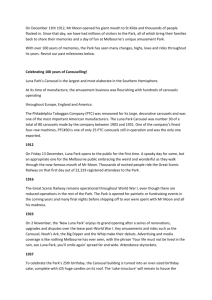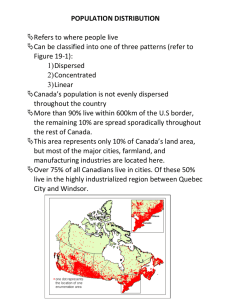A Regional Overview of the La Luna Formation and the
advertisement
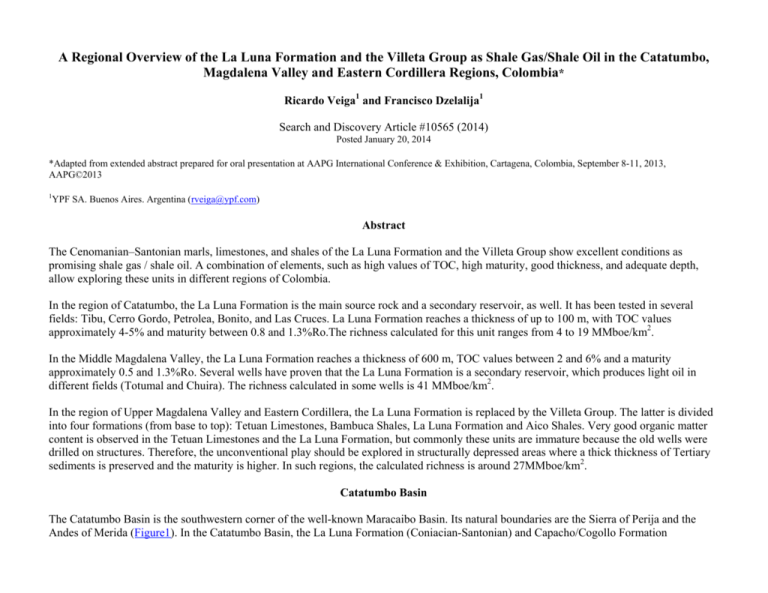
A Regional Overview of the La Luna Formation and the Villeta Group as Shale Gas/Shale Oil in the Catatumbo, Magdalena Valley and Eastern Cordillera Regions, Colombia* Ricardo Veiga1 and Francisco Dzelalija1 Search and Discovery Article #10565 (2014) Posted January 20, 2014 *Adapted from extended abstract prepared for oral presentation at AAPG International Conference & Exhibition, Cartagena, Colombia, September 8-11, 2013, AAPG©2013 1 YPF SA. Buenos Aires. Argentina (rveiga@ypf.com) Abstract The Cenomanian–Santonian marls, limestones, and shales of the La Luna Formation and the Villeta Group show excellent conditions as promising shale gas / shale oil. A combination of elements, such as high values of TOC, high maturity, good thickness, and adequate depth, allow exploring these units in different regions of Colombia. In the region of Catatumbo, the La Luna Formation is the main source rock and a secondary reservoir, as well. It has been tested in several fields: Tibu, Cerro Gordo, Petrolea, Bonito, and Las Cruces. La Luna Formation reaches a thickness of up to 100 m, with TOC values approximately 4-5% and maturity between 0.8 and 1.3%Ro.The richness calculated for this unit ranges from 4 to 19 MMboe/km2. In the Middle Magdalena Valley, the La Luna Formation reaches a thickness of 600 m, TOC values between 2 and 6% and a maturity approximately 0.5 and 1.3%Ro. Several wells have proven that the La Luna Formation is a secondary reservoir, which produces light oil in different fields (Totumal and Chuira). The richness calculated in some wells is 41 MMboe/km2. In the region of Upper Magdalena Valley and Eastern Cordillera, the La Luna Formation is replaced by the Villeta Group. The latter is divided into four formations (from base to top): Tetuan Limestones, Bambuca Shales, La Luna Formation and Aico Shales. Very good organic matter content is observed in the Tetuan Limestones and the La Luna Formation, but commonly these units are immature because the old wells were drilled on structures. Therefore, the unconventional play should be explored in structurally depressed areas where a thick thickness of Tertiary sediments is preserved and the maturity is higher. In such regions, the calculated richness is around 27MMboe/km2. Catatumbo Basin The Catatumbo Basin is the southwestern corner of the well-known Maracaibo Basin. Its natural boundaries are the Sierra of Perija and the Andes of Merida (Figure1). In the Catatumbo Basin, the La Luna Formation (Coniacian-Santonian) and Capacho/Cogollo Formation (Cenomanian-Turonian) (Figure 2) are the source rocks studied. The former is also a secondary reservoir which produces light oil and gas in several fields in Catatumbo Basin. La Luna Formation has been a well-studied unit by several authors in the Catatumbo region (Yurewicz et al., 1998; Mondragon, 2002, Rangel and Hernandez, 2007, Rangel 2012). La Luna Formation is approximately 60-70 m thick and it is composed of organic-rich mudstones, wackestones and minor shales. This unit represents a period of maximum transgression, with anoxic deposition in the northern regions of South America (Macellari, 1988). Geochemical analyses have shown that La Luna Formation is the principal source rock in Maracaibo Basin (Talukdar et al., 1986, Talukdar and Marcano, 1994, Escalona and Mann, 2006). La Luna TOC values range from 1.5 to 9.6 wt% (Talukdar and Marcano, 1994), with an average of approximately 3.2 wt% (Montes, 2009) to 4.5 wt% (Yurewicz et al. 1998). The organic matter is mainly amorphous with an original kerogen type II. The Hydrogen Index (HI) is low (<200 mgHC/gTOC) as a result of a high thermal transformation of the organic matter (Rangel, 2012). On the other hand, the Capacho Formation is composed by dark gray to black shales and limestones, 180450 m-thick. Capachos TOC values range between 1 and 5 wt% with an average of 1.27 wt%(Yurewicz et al., 1998) to 2.1wt% (Rangel, 2012). The thermal transformation of the organic matter is a key issue in defining the prospective areas for shale oil and shale gas. The maturity of the basin based on vitrinite reflectance shows a higher thermal gradient in the south region. The vitrinite reflectance profiles in wells located in the southern area show a higher maturity trend than in wells in the northern areas (Figure 3). A maturity map of the Catatumbo Basin shows a gas zone in the southern area; the oil zone is in the north-central region, and an inmature zone is located in the eastern portion. A potential overmature area is located between Tibu and Rio de Oro, as a result of a regional structural depression where La Luna has an overburden of some 5000 m (Figure 4). The maturity observed in different wells shows that the oil window is reached at very shallow depths (approximately 600m), whereas the gas window occurs between 1200 m and 2000 m. The shallowness of the oil and gas windows can be explained by a major compressional uplift in the Miocene, which eroded 1000-2000 m of sediments. Several 1D models were performed to define timing of generation, expulsion, and the retention of hydrocarbons by the different source rocks. A 1D model performed in the oil zone (e.g., Eslabones-1 well) shows that the oil window was reached when the source rocks was buried to a depth of 2000 m some 40 Ma (Figure 5). Based on that determination, the hydrocarbon generation in Capachos and La Luna formations started in the middle Eocene, and the expulsion occurred in the late Miocene. The timing of generation/ expulsion is very sensitive to the kinetic parameters of the organic matter. Kinetics parameters of the La Luna Formation (Tocco et al., 1997) can produce large changes in the generation and expulsion timings (Figure 6). Petrophysical evaluations and geochemical models have been conducted to evaluate the amount of hydrocarbons retained in the source rocks as free oil/gas. In the Cerro Gordo area (South Catatumbo) the La Luna Formation produces gas from fractured limestones. The gamma-ray log shows two progradational cycles with high resistivity at the top of each cycle (Figure 7). The petrophysical evaluation yields an average porosity of 6%, gross reservoir of 70 thick and hydrocarbon saturation (gas) of approximately 88%; the richness calculated with logs is 22 MMboe/km2. On the other hand, the geochemical modeling shows that the La Luna Formation has generated between 150 and 760 bbl/acre*ft. Considering an expulsion efficiency (volume of expelled hydrocarbon / volume of generated hydrocarbon) of 50%, the volume of hydrocarbon retained in La Luna Formation ranges from 80 to 380 bbl/acre*ft (or 4 to 19 MMboe/km2). A similar analysis performed for Capachos Formation estimates richness between 3-9 MMboe/km2. A log-normal distribution using minimum and maximum values as P99 and P1, respectively, helped to calculate a mean richness of 10MMBoe/km2 for La Luna Formation and 5 MMBoe/Km2 for Capachos Formation. The region of interest for unconventional play could reach an area of 1380 km2 (740 km2 for shale oil+640 km2 for shale gas). Middle Magdalena Valley The Middle Magdalena Valley is a well-known region in Colombia. Several papers about source rocks and petroleum systems have been published (Zumberge, 1984; Schamel, 1991; Ramon and Dzou, 1999; Rangel et al., 2000a; Rangel et al., 2000b, Montes, 2009). The northern area of Middle Magdalena Valley contains several fields with production in the La Luna Formation and Cretaceous Basal Limestones. These fields show reserves (P+P) usually lower than 10MMBo (Figure 8). Previous workers (Reyes et al., 1998; Rangel et al., 2000a; Rangel et al., 2000b) have divided the La Luna Formation into three members (from base to top): Salada, Pujamana and Galembo (Figure 9). TOC values in Pujamana and Salada members average approximately 3.5 wt% and 4.5 wt%, respectively (Zumberge, 1984), whereas TOC values in the Galembo Member reach 2.4% (Rangel, 2000b). On the other hand, data from wells show an excellent source rock potential in La Luna Formation. For example, in Norean-1 well, La Luna is 546 m thick with an average TOC value of 3.14 wt%; the Hydrogen Index (HI) is close to 302 mgHC/gTOC, and the S2 ranges from 5 to 27 mg/gRock (Figure 10). The maturity of the source rock is a critical issue for this play. Raw data from Norean -1 and Morales-1 wells (Montes, 2009) show an immature to early mature source rock in the La Luna Formation. However, regional 2D lines help to define a deep depocenter to the SE, where this unit could be in the oil and gas window (Figure 9). A petrophysical evaluation for the Norean-1 well shows two progradational cycles in the upper portion with net pay thickness of 95 m, average porosities of approximately 10%, clay content (Vclay) close to 40%, and hydrocarbon saturation of almost 70%.The best reservoirs are at the top of each cycle, coinciding with a section of high values of S1/TOC (Figure 11).The richness calculated by petrophysical evaluation is between 4 MMboe/km2 and 41 MMboe/km2 (P90-P10, respectively); the highest richness calculated is close to 100 MMBoe/km2 in Morales-1 in a region with low thermal transformation. The area where the La Luna Formation would have reached adequate maturity extends approximately 1400 km2 (P50=1913 km2 by Garcia Gonzalez et al., 2009). Upper Magdalena Valley and Eastern Cordillera In the region of the Upper Magdalena Valley and Eastern Cordillera, the La Luna Formation is part of the Villeta Group (Figure 12). The latter is divided into four formations (from base to top): Tetuan Limestone, Bambuca Shale, La Luna Formation and Aico Shale, or Olini Formation (Sarmiento and Rangel, 2004). Very good source rocks are observed in the basal (Tetuan Limestone) and middle portions (La Luna Formation) of the Villeta Group (Buitrago, 1994) (Table 1). Most commonly these units are immature because the samples are from wells drilled on structural highs, where the thickness of Tertiary sediments was reduced by erosion (Figure 13). Therefore, a critical point is to find areas where the source rocks are deeper in order to increase their thermal maturity. The critical parameters controlling thermal maturation of source rocks in the Cordillera are the amount of burial by Tertiary sediments and the timing of erosional denudation (Toro et al., 2004) Based on this, the synclinal areas would be the best regions to explore this play concept. Several pseudo-wells were modeled in the synclinal areas to estimate the volume of hydrocarbons retained in the source rocks. Due to the lack of wells drilled in these areas, the models used cannot be calibrated with real data; however, they help in estimating ranges of richness of the source rock. A pseudo-well performed in the Colombia synclinal area show that the hydrocarbons retained in the source rocks ranges from 3 to 18 MMboe/km2. On the other hand, petrophysical studies performed in the following wells (Alpujarra-1, Saltaren-1, Providencia-1 and Providencia-2) show a richness of 7.7 to 80 MMboe/km2, with a mean value of 27 MMboe/km2. Based on these analyses and calculations, the Eastern Cordillera shows 4 main synclinal axes with NE-SW direction: San Juan, Colombia-Cabrera, Prado and Fusa, with a total area of approximately 1500-1750 km2, where the unconventional play could be in play (Figure 14). Selected References Agencia Nacional de Hidrocarburos, Universidad Nacional de Colombia, RA Geologia E.U. and GEMS Ltda., 2009, Organic Geochemistry Atlas of Colombia: Universidad Nacional de Colombia, Earth Sciences Research Journal, v. 13, Special Edition, 134 p. Buitrago, J., 1994, Petroleum system of the Neiva Area, Upper Magdalena Valley, Colombia, in L.B. Magoon and W.G.Dow, eds.,The Petroleum System from Source To Trap. AAPG. Memoir 60, p. 483-497. Cooper, M.A., F.T. Addison, R. Alvarez, M. Coral, R.H. Graham, A.B. Hayward, S. Howe, J. Martinez, J.Naar, R.Peñas, A.J.Pullham and A. Taborda, 1995, Basin development and tectonic history of the Llanos Basin, Eastern Cordillera and Middle Magdalena Valley. Colombia: AAPG Bulletin, v. 79/10, p. 657-678. Escalona, A., and P. Mann, 2006, An overview of the petroleum system of Maracaibo Basin: AAPG Bulletin, v. 90/4, p. 657-678. Garcia Gonzalez, M.R. Mier Umaña, L.E. Cruz Guevara, and Mauricia Vasquez, 2009, Informe Ejecutivo. Evaluación del Potencial Hidrocarburífero de las Cuencas Colombianas: Grupo de Investigación en Geología de Hidrocarburos y Carbones. Universidad Nacional de Santander y ANH. INGEOMINAS, 2007, Gómez Tapias, J., A. Nivia Guevara, N.E. Montes Ramírez, D.M. Jiménez Mejía, M.L. Tejada Avella, J. Sepúlveda Ospina, J.A. Osorio Naranjo, T. Gaona Narváez, H. Diederix, H. Uribe Peña, and M. Mora Penagos, M., compiladores, Mapa Geológico de Colombia. Macellari, C., 1988, Cretaceous paleogeography and depositional cycles of the western South America: Journal of the South America Earth Sciences I, p. 373-418. Mondragon Castillo, J.C., 2002, Proyecto de Evaluación Regional de la Cuenca de Catatumbo. Internal Report ECOPETROL. Montes, L., ed., 2009, Organic Geochemitry Atlas of Colombia: ANH, Universidad Nacional de Colombia, RA Geologia, EU and GEMS Ltda. Ramon, J.C., and L.I. Dzou, 1999, Petroleum geochemistry of the Middle Magadalena Valley: Colombia: Organic Geochemitry, v. 30, p. 249266. Rangel,A., B. Giraldo, R. Munar, I. Olaya, M. Garcia, J. Gutierrez, P. Parra, and Ch. Niño, 2000a,. Estratigrafía química y facies orgánicas del Terciario Inferior y Cretácico Superior del Piedemonte Llanero y Valle Oriental del Magdalena. Internal Report. ECOPETROL- ICP. Rangel, A., Parra, P. and Niño, C., 2000b, The La Luna Formation: chemostratigraphy and organic facies in the Middle Magdalena Basin: Organic Geochemistry, v. 31/12, p. 1267-1284. Rangel, A., and R. Hernandez, 2007, Thermal maturity history and Implications for Hydrocarbon Exploration in the Catatumbo RegionColombia: Ciencia, Tecnología y Futuro, v. 3.3. Rangel, A. 2012. Thermal history and implications for evaluation of the exploration risk in the Catatumbo Basin: XI Simposio Bolivariano de Cuencas Subandinas. Memorias. Reyes Santos, J.P., A.F. Díaz, M.M. Monsalve, and M. Barragán, M., 2000, Secuencia calcárea del Cretáceo del Valle Medio del Magdalena, Colombia, una nueva frontera exploratoria:, VII Simposio Bolivariano - Exploracion Petrolera en las Cuencas Subandinas: Asociación Colombiana de Geólogos y Geofísicos del Petróleo, Caracas, Venezuela, Memorias 1, p. 426-442. Sarmiento L F., and A, Rangel, 2004, Petroleum system in the Upper Magdalena Valley, Colombia: Marine and Petroleum Geology, v. 21, p. 373-391. Schamel, S., 1991, Middle and Upper Magdalena basins, Colombia, in K.T. Biddle, ed., Active Margin Basins: AAPG Memoir 52, p. 283-301. Talukdar, S., and F. Marcano, 1994, Petroleum systems of the Maracaibo Basin, in L.B. Magoon, and W.G. Dow, eds., The Petroleum System from Source to Trap: AAPG. Memoir 60, p. 463-481. Tocco, R. F. Parnaud, O. Gallango, M. Alberdi, and H. Passalacqua, 1997, Geochemical modelling of the principal source rocks of the Barinas and Maracaibo basins, Western Venezuela: Boletín Sociedad Venezolana de Geólogos, v. 22/2, p. 17-28. Toro, J., F. Roure, N. Bordas-Le Floch, S. Le Cornec-Lance, and W. Sassi, 2004, Thermal and kinematic evolution of the Eastern Cordillera fold and thrust belt, Colombia, in R. Swennen, F. Roure, and J.W. Granath, eds.,Deformation, Fluid Flow and Reservoir Appraisal in Foreland Fold and Thurst Belts: AAPG Hedberg Series no.1, p. 79-115. Yurewicz, A., D.M. Advocate, H.B. Lo, and E.A. Hernandez, 1998. Source rocks and oil families, southwest Maracaibo Basin (Catatumbo Subbasin), Colombia: AAPG Bulletin, v. 82/7, p. 1329-1352. Zumberge, J.E., 1984. Source rocks of the La Luna Formation (Upper Cretaceous) in the Middle Magdalena Valley, Colombia, in J.G. Palacas, ed., Petroleum Geochemistry and Source Rock Potential of Carbonate Rocks: AAPG Studies in Geology no. 18, p. 127-133.. Figure 1. Location map of the Catatumbo region. 1-- ; m ® :f g j• l ® a ® • ®+ • -.*+ ® ® ~+ Y -- Figure 2. General stratigraphic chart of the Catatumbo Basin. Ro (%) 0,1 1 10 1500000 0 1000 Rio de Oro Puerto Barco 2000 Tibu 3000 VENEZUELA Campó Yuca Oru Z (ft) 4000 Sardinata Petrolea Carbonera 5000 Cerro Gordo Rio Zulia 6000 Rio de Oro 14 7000 Cerrito 8000 Cerro Gordo 3 1360000 Sardinata 3K 9000 Cerrito 1 10000 Oil/Gas Field 1120000 0 10 km 1180000 Figure 3. Vitrinite Reflectance vs Depth crossplot, based on data from Rangel & Hernandez, 2007. Wells located in the southern region of Catatumbo basin (e.g., Cerrito-1 and Cerro Gordo-3) show a higher maturity trend than Sardinata 3 and Rio de Oro-14. 1520000 Inmature Shale Oil Rio de Oro Shale Gas Overmature? B Veta-1 C A B C 30677 m VENEZUELA Tibu A Santa Helena COLOMBIA Petrolea Esperanza Leoncito Cerro Gordo Mucurera-3 Cerrito-1 1320000 Cucuta-2 0 20 km 1120000 40 km 1180000 Figure 4. Maturity map for the La Luna Formation in Catatumbo Basin. The gas zone is located to the south. The oil zone is in the center, and the immature area is located in the eastern region. The cross section ABC shows a deeper structural depression where the La Luna Formation could be overmature. CMP= El(P ;TH= SHF TI=5 ;KEI(P= Sat;PRM= PL 01=159.625 100 -+----~-----L-------------L------~ o illl 80 ~ U 0 6000 ft-2000 m ~ ooo IOJ OJ E U) 60 u ro ~ 't U ::J 0 if) I- --.. if) if) 8000 ~O ..0 ::J (J) ~ ro 1:i U) ~ lQOOO U 0 I 20 [ 8MJ ,! I" 40 m.iJ. Depth Subsurface bottom 11000 0 100 80 60 10 20 0 Gas Generated I TOC bottom Oil Generated I TOC bottom Age (my) Figure 5. Generation of hydrocarbons and subsidence of the La Luna Formation in the Eslabones-1. The generation began in the Eocene when the source rock reached a burial of 2000 m. 160 Kinetics La Luna (Tocco, 1997) 140 Kinetics KII 100 80 60 Oil Generated Volume Ratio (bbl/acre*ft rock) 120 40 20 0 90 80 70 60 50 40 30 20 10 0 Age (m.y.) Figure 6. Oil Generated in the La Luna Formation (Eslabones-1) as a function of kinetic parameters. Notice how the change in the kinetic parameters affects the timing of generation and the volume of hydrocarbon generated in the same stage of thermal maturity. Well: Cerro Gordo 1 Top Reservoir Base Reservoir Gross Reservoir (H) AvVclay ft ft ft 2918 3146,25 228,25 AvPhi AvSw Phi*H Phi*So*H fraction fraction fraction 0,16 0,059 0,124 ft ft 13,25 11,6 Figure 7. Petrophysical evaluation of the La Luna Fomation in Cerro Cordo-1 well. --._,, - ----_. - ... -- -I ,- -" II, ~= ~ 1- .-.."-.--- -- - .-..., .---, !. Ii I n. • m -- 5s,;", "'- ----- - • Figure 8. Location map of the Middle Magdalena Valley and stratigraphic chart. The northern area of the Middle Magdalena shows several fields with oil and gas production from La Luna and Cretaceous limestones. A’ A Mesa+Real A A’ 100 km Girón o PK 10 km Figure 9. Seismic section A-A’ showing the deepening of the La Luna Formation to the southeast part of the study area. ,,, Norea n-1 ~ , b! ~i ~! , f i' Figure 10. RockEval data from Norean-1 well. Note TOC values are higher than 2% and a high S1/TOC between 2070 and 3070 ft (844936m). All samples are immature or early mature. Inmature Zone Oil Zone Norean Oil Zone area=1380 km2 Progradational Cycles Norean Figure 11. General map of the northern of the Middle Magdalena Valley, showing the extent of the oil zone. The best reservoirs in the La Luna Formation are located in the tops of the prograding cycles. Villeta Figure 12. Example, in Tesalia–1 well, of the Villeta Group in the Upper Magdalena and Eastern Cordillera. The Villeta Group is divided into 4 units: Tetuan Limestone, Bambuca Shale, La Luna Limestones and Aico Aico Shale. 3000m New play Unconventional Structural play KTcG Ne Kv Kcb 0m 3000m Kmo Pg 0m KTcG Jr -3000m A Jr Kcb Kv Kcb A’ Jr Base Neogene Top Guaduas Top Montserrate -3000m Top Villeta Top Caballos Top Jurassic Figure 13. Schematic cross section in the Eastern Cordilllera, showing the traditional play concept and the unconventional play concept. The traditional play is focused on structures with targets in sandstones of the Caballos Formation and Monteserrate Formation. The unconventional play is focused in synclines areas where the source rocks in the Villeta Group (Tetuan Limestone and La Luna Formation) would have reached optimal maturity conditions. Jr=Jurassic, Kcb=Caballos Formation, Kv=Villeta Group, Kmo=Montserrate Formation, KTcG=Guaduas Formation, Pg= Paleogene and Ng= Neogene. See location in Figure 14. 4°35’56,57’’N 74°04’51,3’’W BOGOTA MP3 A Name Age Q-ca Quaternary Alluvial fan Q2-Vc Holocene Volcaniclastic N2Q1-VCc Plio‐Pleistocene Volcaniclastic n3-n7-Sc Tortonian Continental E-Sctm Eocene Continental & Marine E-Sc Eocene Continental K2e1-Sctm Late Cretaceous Continental & Marine K1-Sctm Early Cretaceous Continental & Marine T3J1-VCc Late Triassic‐Early Jurassic Volcaniclastic T3J1-Pi Late Triassic‐Early Jurassic Igneous T3-Sm Late Triassic Marine PT-Sc Permo‐Triassic Continental DC-Sctm Devonian Continental & Marine CAO-Sm Cambro‐Ordovician Marine NP?CA?Mev NeoProterozoic Metamorphic MesoProterozoic Metamorphic MP3 A’ Environments Based on Ingeominas, 2007 1 2 3 4 Sinclinal San Juan Sinclinal Colombia/Cabrera Sinclinal Fusa Sinclinal Prado 100 km Figure 14. Regional geologic map of the Eastern Cordillera (INGEOMINAS, 2007). The synclines areas with Tertiary sediments could be the more prospective regions to explore unconventional plays. Table 1. Geochemical (Rock-Eval) data from wells in Upper Magadalena and Eastern Cordillera.
